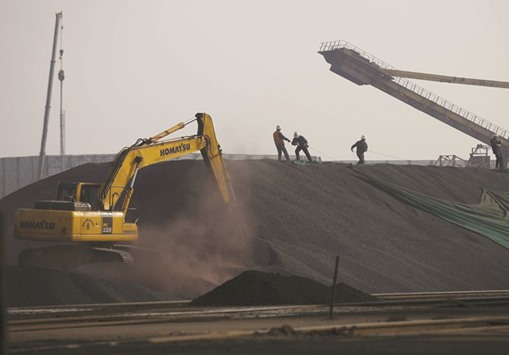Iron ore, already on its best run of monthly gains in almost five years, could beat expectations in 2017 and touch the $100 a tonne level for the first time since mid-2014 as government support propels China’s surging steel appetite.
Steel demand in the world’s top producer and consumer is estimated to grow between 5% and 10% on infrastructure investments and as policymakers seek to maintain stable growth ahead of a key meeting later this year, according to AMP Capital Investors, which manages about A$165bn ($126bn).
Ore with 62% content in Qingdao rose 1.2% to $92.36 a dry metric tonne last week, according to Metal Bulletin data. It touched $94.86 on February 21, the highest since August 11, 2014.
“Iron ore prices will probably remain higher than people think” should government support continue to keep infrastructure demand high, Peter Harris, Sydney-based senior resources analyst at AMP Capital said in a phone interview. “You could see iron ore at $100, you could see it at $90. That’s certainly not the expectation that you would have had at the start of this year.”
Gains of more than 20% for iron ore futures through to the December contract on China’s Dalian Commodity Exchange point to longer-term support for prices amid a stronger steel market, according to Daniel Hynes, senior commodities strategist at Australia & New Zealand Banking Group.
“What we are seeing is really strong fixed-asset demand growth in China,” AMP’s Harris said last month. “We’re pretty confident that the relatively strong steel demand growth that we’ve seen will continue.”
Seaborne iron ore is being supported by better-than- expected steel demand, declining output from China’s mines and soaring profitability of steel mills that means they’re seeking premium imported material and able to absorb higher prices.
Steel sector reforms in China aimed at tackling issues including pollution may see a further cut of 65mn tonnes of capacity this year to meet a government target of 140mn tonnes by 2020, according to Macquarie Group Ltd Capacity cuts are seen favouring higher-grade imported ore.
By using higher profits to pay down debt, China’s mills are likely to be better prepared for a possible further bout of reforms in 2018, according to AMP Capital’s Harris. “They will be able to live through tougher times, because the balance sheets will be repaired,” he said.
AMP Capital forecasts iron ore prices to average about $85 a tonne this half, and $70 a tonne in the second half. The material will average $59.62 this year, according to the median forecast among 14 analysts’ estimates compiled by Bloomberg.
Not everybody is as optimistic. A surge in activity in 2016 in China’s construction, infrastructure and real-estate sectors that boosted steel and iron ore won’t be repeated, according to McKinsey & Co, and the nation’s steel production is likely to fall each year through 2020.
Iron ore isn’t likely to remain at current prices above $90 a tonne, Reserve Bank of Australia Governor Philip Lowe said in testimony to a parliamentary panel last week, echoing warnings from producers BHP Billiton and Fortescue Metals Group that prices will retreat.
While China’s steel demand may slow in the second half, China’s infrastructure spending plans, which include rail programs and “One Belt, One Road” initiatives could eventually offer a new impetus for consumption, according to Yi Zhu, an analyst at Bloomberg Intelligence in Hong Kong.

Labourers work on a pile of iron ore at a steel factory in Tangshan, China. Iron ore, already on its best run of monthly gains in almost five years, could beat expectations in 2017 and touch the $100 a tonne level for the first time since mid-2014 as government support propels China’s surging steel appetite.
